Planning
|
|
Understanding what needs to be covered is an important part of the planning process, so do some quick calculations to better understand the situation. For indoor coverage, understand the effects of the attenuating and reflecting materials where the coverage is desired. A link budget will tell you what is practical given the environment and how to plan cells. With a link budget, one can have an estimate of how many cells will be required for the project. Tradeoffs take place between more cells and running more power. For an outdoor application, also consider checking the Fresnel zone. For example, the tradeoff between working on one long-distance shot versus two back-to-back links can be discovered by working out a few things on paper first.
Fresnel Zone For a point-to-point shot, it is important to understand the effects of the Fresnel Zone. For an indoor application, this can be skipped since the losses are calculated into the link budget. So what is the Fresnel Zone?
In a Fresnel Zone, the signal extends from the transmitting antenna to form an ever-expanding cone. Although some of the signal travels directly in the line of sight along the center of the cone, other parts of the signal reradiate off points along the way. At the receiver, signals from the direct line of sight indirectly cancel and add to each other. The first Fresnel Zone is the surface containing every point for which the sum of the distances from those points to the two ends of the path is exactly a half wavelength longer than the direct end-to-end path. The second Fresnel Zone is the surface containing every point for which the sum of the distances from those points to the two ends of the path is exactly one wavelength longer than the direct end-to-end path. Figure 7-4 shows the first and second Fresnel Zones.
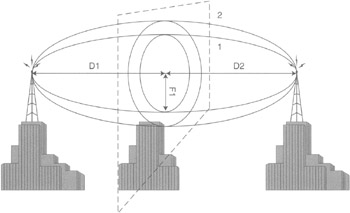
Figure 7-4: First and second Fresnel Zones
One can calculate the perpendicular distance of the Fresnel Zone from the line that connects the transmitter and the receiver using the following nth Fresnel Zone formula:
| (7-1) |  |
where
-
N is the Fresnel Zone number; N = 1 is the first Fresnel Zone.
-
λ is the wavelength (meters).
-
D1 and D2 are the distances to the endpoints (meters).
If reflections of the signal are made from an odd-numbered Fresnel Zone, the signal level will cancel at the receiver, but if the reflection is from an even-numbered Fresnel Zone, it will add at the receiver. Therefore, on long-distance shots, it is necessary to take into account ground/water reflections and vertical surfaces like tall buildings.
Since the majority of the transmitted power is in the first Fresnel Zone, any time the path clearance between the terrain and the line-of-sight path is less than 0.6F1 (six-tenths of the first Fresnel Zone distance), some knife-edge diffraction loss will occur. The amount of loss depends on the amount of penetration. To find out if any obstruction is taking place in the Fresnel Zone, a profile of the terrain is superimposed with the ellipse created by the nth Fresnel Zone formula with the first Fresnel Zone (N=1) and multiplying the result by 0.6 for repetitive points across the profile.
It is possible to gain in the signal strength at the receiver up to 3 dB by having a flat surface such as a lake, a highway, or a smooth desert area at the second Fresnel Zone in such a way that the signals get reinforced at the receiver.
Decibels and Signal Strength Rather than keep track of all those zeroes, amplifier power is measured in a logarithmic scale using dB. Then, instead of multiplying and dividing all the gains, it's much simpler to add and subtract dBs.
| (7-2) |
Decibel readings are positive when the output is larger than the input, and they are negative when the output is smaller than the input. Each 10 dB change corresponds to a factor of 10, and 3 dB changes are a factor of 2. Thus, a 33 dB change corresponds to a factor of 2000:
33 dB = 10 dB + 10 dB + 10 dB + 3 dB = 10 × 10 × 10 × 2 = 2000
Power is sometimes measured in dBm. To find the dBm ratio, simply use 1 mW as the input in the first equation. It's helpful to remember that doubling the power is a 3 dB increase. A 1 dB increase is roughly equivalent to a power increase of 1.25, and a 10 dB increase in power is a power increase of 10 times. With these numbers in mind, quickly perform most gain calculations in your head.
How to Calculate a Link Budget
Link budget planning is an essential part of the network-planning process for both indoor and outdoor applications. A link budget helps to dimension the required coverage, capacity, and QoS requirement in the network. In a typical 802.11 link, two link budget calculations must be made: the link from the AP to the client adapter card, and the other link from the client adapter card back to the AP. Link budgets can be used to determine if the link design meets the designer's criteria for range, throughput, and BER.
A link budget basically adds all the gains and losses to the transmitter power (in dB) to yield the received power. In order to have adequate signal at the receiver, the power presented to the receiver must be at least as much as the receive sensitivity. The link budget for the AP to the client adapter card is shown in Figure 7-5.

Figure 7-5: Calculating a link budget
Transmiter Power and Antenna Gain The combination of power output at the antenna and the gain of the antenna itself are legally limited by FCC rules and regulations in the U.S. In other countries, similar regulations exist but will differ. Page 206 Chapter 7 contains an explanation of the legal limits.
For Wi-Fi, the maximum power output and antenna gain is limited based on what frequency band is used and whether the application is point to point or point to multipoint. The manufacturer of an access point or client adapter card will typically specify the output power in their spec sheet in milliwatts and dBm—decibels over a one milliwatt reference.
To convert from milliwatts to dBm:
dBM = log (power in milliwatts / 1 milliwatt)
So for example, how many dBm is 4 watts? 4 watts = 4000 milliwatts.
log (4000 mW / 1 mW) = log 4000 = 36 dBm
Three good rules of thumb to convert into dB are:
-
A doubling is 3dB
-
10 times is 10 dB
-
Decibels add where factors multiply
So log of 4000 can be calculated as follows:
2 × 2 × 10 × 10 × 10 = 3 dB + 3 dB + 10 dB + 10 dB + 10 dB or 36 dB
The m in dBm stands for the reference of one milliwatt.
For antennas, the gains is usually specified in dBi, or decibels over isotropic. The i in dBi stands for the reference of an isotropic antenna.
So for example we can calculate the effective radiated power of a 23 dB gain antenna being fed with 100 milliwatt or 20 dBm source (client adapter card or access point)
20 dBm + 23 dB = 46 dBm
46 dBm = 2 × 2 × 10 × 10 × 10 × 10 or 40,000 milliwatts or 40 W
Path Loss The most difficult part of calculating a link budget is the path loss. Outdoors, the free-space loss is well understood. The path loss equation[2] for outdoors can be expressed as
| (7-3) |
At 2.4 GHz, the formula simplifies to
| (7-4) |
This formula holds true as long as one can see along the line of sight from the receiver and the transmitter, and one has a sufficient amount of area around the Fresnel Zone. Indoors, this formula is more complicated and depends on factors such as building materials, furniture, and occupants.
At 2.4 GHz, one estimate follows this formula:
| (7-5) |
At 5.7 GHz, the formula looks like this:
| (7-6) |
Receive Antenna Gain The receive antenna gain adds into the link budget just like the transmit antenna. Adding gain to an antenna is balanced gain since it adds gain for both transmit and receive.
Link Margin Fade margin is the difference, in dB, between the magnitude of the received signal at the receiver input and the minimum level of signal determined for reliable operation. The higher the fade margin, the more reliable the link will be. The exact amount of fade margin required depends on the desired reliability of the link, but a good rule-of-thumb is 20 to 30 dB. Fade margin is often referred to as the thermal or system operating margin.
Diffraction Losses Diffraction occurs when the radio path between the transmitter and the receiver is obstructed by a surface that has sharp irregularities or an edge. The secondary waves resulting from the obstructing surface are present behind the obstacle. When close to line of sight, diffraction losses can be as little as 6 dB. In non line of sight obstacles, diffraction losses can be 20 to 40 dB.
Coax and Connector Losses Connector losses can be estimated at 0.5 dB per connection. Cable losses are a function of cable type, thickness, and length. Generally speaking, the thicker and better built the cable, the lower are the losses (and the higher the cost). As can be seen from Table 7-5, coax losses are nearly prohibitive in the 2.4 and 5.8 GHz bands. The best option is to use coax as sparingly as possible and locate the microwave transceiver as close to the antenna as possible in an environmental enclosure.
| Cable type | 2.4 GHz | 5.8 GHz | ||
|---|---|---|---|---|
| dB/100ft | dB/100m | dB/100ft | dB/100m | |
| RG-58 | 32.2 | 105.6 | 51.6 | 169.2 |
| RG-8X | 23.1 | 75.8 | 40.9 | 134.2 |
| LMR-240 | 12.9 | 42.3 | 20.4 | 66.9 |
| RG213/214 | 15.2 | 49.9 | 28.6 | 93.8 |
| 9913 | 7.7 | 25.3 | 13.8 | 45.3 |
| LMR-400 | 6.8 | 22.3 | 10.8 | 35.4 |
| 3/8" LDF | 5.9 | 19.4 | 8.1 | 26.6 |
| LMR-600 | 4.4 | 14.4 | 7.3 | 23.9 |
| 1/2" LDF | 3.9 | 12.8 | 6.6 | 21.6 |
| 1/8" LDF | 2.3 | 7.5 | 3.8 | 12.5 |
| 1 1/4" LDF | 1.7 | 5.6 | 2.8 | 9.2 |
| 1 5/8" LDF | 1.4 | 4.6 | 2.5 | |
|
[a]Andrew http://www.andrew.com/products/trans_line/default.aspx Times Microwave http://www.timesmicrowave.com/telecom/pdf/LMRGuide.pdf Belden http://bwcecom.belden.com/ | ||||
Attenuation There are a number of atmospheric factors that will diffuse or otherwise disrupt the flow of radio waves through the atmosphere. Those factors include rain and fog, trees, fiberglass, glass and other building materials.
Rain and Fog When deploying in a rainy or foggy climate, it may be necessary to plan additional signal loss due to rain or fog. 2.4 GHz signals may be attenuated by up to 0.05 dB/km (0.08 dB/mile) by heavy rain (4 inches/hr). Thick fog produces up to 0.02 dB/km (0.03 dB/mile) attenuation. At 5.8 GHz, heavy rain may produce up to 0.5 dB/km (0.8 dB/mile) attenuation, and thick fog up to 0.07 dB/km (0.11 dB/mile). Even though rain itself does not cause major propagation problems, rain will collect on the leaves of trees and will produce attenuation until it evaporates.
Trees Trees can be a significant source of path loss,[3] and a number of variables are involved, such as the specific type of tree, whether it is wet or dry, and, in the case of deciduous trees, whether the leaves are present or not. Isolated trees are not usually a major problem, but a dense forest is another story. The attenuation depends on the distance the signal must penetrate through the forest, and it increases with frequency. The attenuation is of the order of 0.35 dB/m at 2.4. This adds up to a lot of path loss if your signal must penetrate several hundred meters of forest.
Fiberglass The loss for a radome, which is a plastic shell that protects an antenna from the elements in outdoor deployments, is about .5 to 1 dB.
Glass A normal, clear glass pane will lose about 3 dB at 2.4 GHz. Although most glass will not affect radio frequency, certain kinds of glass severely attenuate signals.[4] It depends on the glass and the tint material. If the glass is reflective at all on either side, chances are that a signal may not be able to penetrate it. New construction often uses tinted, coated, or High-E glass that is designed to hold heat out. However, it attenuates 802.11 signals. High-E is energy efficient; is usually double-paned, coated, and filled with argon or other inert gasses; and is not necessarily tinted. Tin oxide (SnO2) coatings do not pass RF. Some windows have as much as a 20 dB loss.
Other Building Materials Examples of attenuation through various building materials are shown in Table 7-6.[5]
| Window in brick wall | 2 dB |
| Metal frame glass wall into building | 6 dB |
| Office wall | 6 dB |
| Metal door in office wall | 6 dB |
| Cinder block wall | 4 dB |
| Metal door in brick wall | 12.4 dB |
| Brick wall next to metal door | 3 dB |
Examples In order to better understand how attenuation degrades wireless applications, examples of degrading instances are offered.
Example 1 On the network side is a Cisco 350 AP that operates at its maximum output power at 2.45 GHz into a 6 dB gain omnidirectional antenna. On the other side of a 1 km link is a laptop with a Cisco Aironet 350 WLAN adapter card. Is there sufficient signal to make this work?
| (7-7) |  |
Example 2 A company claims that a distance of 4.3 miles or 7 km can be spanned in a point-to-multipoint application with their antenna using 802.11b. Assume no coax losses, no connector losses, and a perfect line of sight. Does it work with a minimum spec card? Does it work with the best card?
| (7-8) |  |
The worst-case receive sensitivity for an 802.11b card is -80 dBm at 1 Mbps. Quite clearly, the signal is not adequate, and this is only barely enough to leave a link margin of 1.3 dB, which is not a very reliable link. The Cisco Aironet 250 client adapter card is the most sensitive in the industry (1 Mbps: -94 dBm, 2 Mbps: -91 dBm, 5.5 Mbps: -89 dBm, 11 Mbps: -85 dBm) and will yield a link margin of 15.3 dB using a 1 Mbps link.
But can you get back at the AP?
| (7-9) |  |
If the link margin is 15 dB, or the antenna has 23 dB gain, the Cisco 350 client adapter card can be heard at 7 km with this antenna.
Given current technology, what is the best you can do on a point-to-point link?
-
Get more transmit power and better receive sensitivity.
-
Remove noise.
-
Limit any attenuation from the link budget.
-
Get antennas with the most gain for both ends.
-
Go to a lower data rate for better sensitivity (a higher data rate equals less power efficiency).
-
Use two antennas for diversity at both ends.
Premium cards like the Cisco Aeronet 350 card have output power at 100 mW or 20 dBm, and a very sensitive receiver at -85 dBm at 11 Mbps.
If you now go to a lower data rate, such as 1 Mbps, the receive sensitivity is at -94 dBm. A link budget for a record-breaking point-to-point link looks like this:
24 dBm (maximum legal output of transmitter)
+ 24 dBi (grid antenna gain)
- 20 dB (link margin)
- 2 dB (connector losses)
- 2 dB (coax losses)
+ 24 dB gain (grid antenna gain)
+ 94 dBm (minimum received power at 1 Mbps)
= maximum path loss = 142 dbm
-
or about 75 miles (path loss for 120 km at 2.4 GHz is 40 + 20 log[120,000 m])
Under full multipath conditions, this link will have a 1 Mb data rate. Under better conditions, the link may operate at the full data rate of 11 Mbps.
Site Plan Prediction Tools
Indoor propagation tools are available, such as WinProp,[6] campus-wide propagation tools like SitePlanner,[7] and ray-tracing tools like CINDOOR[8] that can be used to model buildings and campuses given a computer-aided design (CAD) floor plan. One of the shortcomings is that the floor plan does not tell you much about the construction materials used in the structure. For example, is the wall made of bricks, Sheetrock, or reinforced concrete? Is the floor totally RF isolated from the one above or below it? Only a walkthrough will tell you these things accurately.
Site Survey
Once things work on paper with an adequate link budget and the Fresnel Zone, one can go out to the site and see if the paper plan works.
Outdoor Site Survey All the data on paper may indicate that everything will work for a particular link. The Fresnel Zone can be checked against a topographical view of the point-to-point shot. You may even use expensive ray-tracing programs to predict the path, but only one way will tell you if the installation will work.
To perform an outdoor site survey for a point-to-point shot, take along binoculars, two-way radios or cell phones, topology maps, a Global Positioning System (GPS), a spectrum analyzer, a 5 and 10 dB attenuator, and your radio equipment to take the trial shot. Have a friend go to another hill and talk to you on the radio.
Drive out to the proposed site and see with the binoculars if the shot is clear. Check for trees or buildings that might block the path. The best time to plan a long-distance shot is during spring when everything is wet and growing. If it's the dead of winter, keep in mind that trees will soon grow leaves again.
Using the location of both endpoints, one can calculate a bearing and tilt angle to point the antenna. Most GPSs have a function to do this built in. High-gain dishes are more difficult to aim the farther out you go. Take both dishes and roughly point them toward each other. Transmit a signal into one dish. With 802.11 gear, link test software enables you to send a series of management frames.
You can take the output of the other dish and feed it into the spectrum analyzer. You will see a display of frequency (across) versus amplitude (up and down). Pick the channel that has the least amount of noise.
Once you get the antennas close, you will see a spike on the frequency that the transmitting dish is tuned to surrounded by noise. Sweep the antenna on each end one at a time and lock down the antenna at the point where the signal is the strongest. At this point, you should have a sufficient SNR ratio to receive the signal with a sufficient margin.
The 5 and 10 dB attenuators can be used in line to check to see if the link margin is adequate. With 15 dB of attenuation in line, a link should last easily for a few hours. If not, you need to plan on larger dishes and amplifiers.
Indoor Site Survey To perform an indoor site survey, prepare by getting the floor plans of the structure. During an initial meeting, find out which areas need to be covered and which ones don't. For example, do you need coverage in locker rooms and bathrooms? Also obtain information about where existing wiring closets are located and if the wiring closets or hub rooms will be used to connect the APs to the wired network.
Then walk through the structure while looking for existing RF sources. If RF sources exist, note which channels the interference is on and the relative signal's strength. Typical cells can cover closed-off areas such as four classrooms or a large area like a basketball gym or a bowling alley.
Starting at the most complicated area, place a potential AP that has to be within 300 feet of the nearest wiring closet, with a cabling path between the two. Then using a laptop with a site survey tool, find the points where 20 dB SNR is observed. This becomes the cell boundary. Place the trial AP so that its 20 dB SNR cell boundary overlaps the one identified by the first trial location. Continue to lay out cells until the whole structure is covered.
How to Make a Frequency Plan
After completing an RF site survey, you'll have a good idea of the number and location of APs necessary to provide adequate coverage and performance for users.
2.4 GHz Frequency Reuse
The 2.4 GHz band has 11 22-MHz-wide channels defined, starting at 2.412 GHz every 5 MHz through 2.462 GHz. Three nonoverlapping channels are available: 1, 6, and 11, as shown in Figure 7-6. These nonoverlapping channels can be used in a three-to-one reuse pattern, as shown in Figure 7-7.
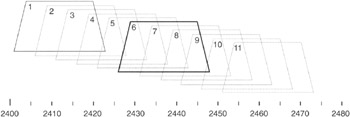
Figure 7-6: 2.4 GHz has three nonoverlapping channels.

Figure 7-7: Three-to-one reuse pattern
5 GHz Frequency Reuse
The operating channel center frequencies are defined at every integral multiple of 5 MHz above 5 GHz. The valid operating channel numbers are 36, 40, 44, 48, 52, 56, 60, 64, 149, 153, 157, and 161. The lower and middle U-NII subbands accommodate eight channels in a total bandwidth of 200 MHz. The upper U-NII band accommodates four channels in a 100 MHz bandwidth. The centers of the outermost channels are 30 MHz from the bands' edges for the lower and middle U-NII bands, and 20 MHz for the upper U-NII band (see Figure 7-8).
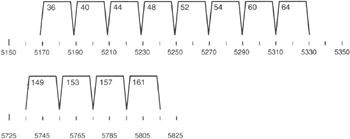
Figure 7-8: 5 GHz channels
Point-to-point links operate on the other four channels: 149, 153, 157, and 161. This allows four channels to be used in the same area.
802.11a APs and client adapter cards operate on eight channels: 36, 40, 44, 48, 52, 56, 60, and 64. This allows two four-to-one reuse patterns to be used (see Figure 7-9).

Figure 7-9: Four-to-one reuse pattern
Using both the low- and mid-frequency ranges together allows a seven-to-one reuse pattern with a spare. The spare can be added for a fill to extend coverage or to add capacity in areas like conference rooms where more capacity is needed (see Figure 7-10).
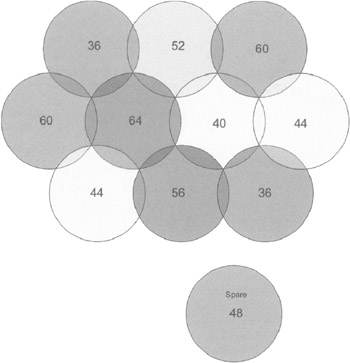
Figure 7-10: Seven-to-one reuse pattern with a spare
Frequency Allocation
For a simple project like one or two APs, simply assign the least used frequencies from the site survey. For more complex projects involving three or more APs, pick a frequency reuse pattern for the frequencies that are used for the project; start with the most complicated part of your site survey and start assigning frequencies. Plan the location of APs initially for coverage, not capacity. Avoid overlapping channels if possible. However, if an area has to be overlapped, plan it such that it is naturally an area where the most capacity would be required, such as in a library, conference room, or lecture hall (see Figure 7-11).

Figure 7-11: Overlap in a central library
For multiple-floor installations, if more than 30 dB of isolation is used between floors (such as concrete and rebar floors), try not to use the same frequency directly above or below a cell that has already been allocated. Where less than 30 dB of isolation is used between floors (such as a two-by-four framed apartment building), the plan needs to take the three-dimensionality of the cell into account (see Figure 7-12).

Figure 7-12: Cells are 3-D in buildings.
Some of the most complex problems are areas where not enough channels are available to plan out the space. In a two-dimensional space, this can happen in areas where a central room has to be covered with surrounding classrooms or offices, such as a library or lab. In a three-dimensional space, this can happen in a tri-level portion of a building (see Figure 7-13).
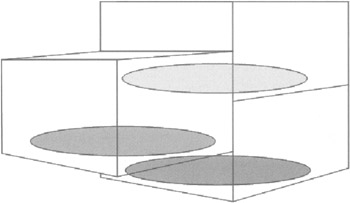
Figure 7-13: A case where RF planning is difficult
The signals from different floors can overlap and intrude on another. In some cases when you have no way around two cells that use the same frequency being bordered against each other, plan the seam to be in areas where no coverage is necessary, such as equipment rooms, restrooms, wiring closets, stairwells, and janitorial supply rooms.
Equipment Selection
Now comes an important phase in network deployment; selecting the equipment that is right for this network. Inevitably, the process is an equation balancing costs vs. capabilities vs. requirements.
How to Pick the Right 802.11 Client Adapter Card Depending on what kind of computers you have, several choices of Wi-Fi adapters are available. Figure 7-14 shows the choices of client adapters available.
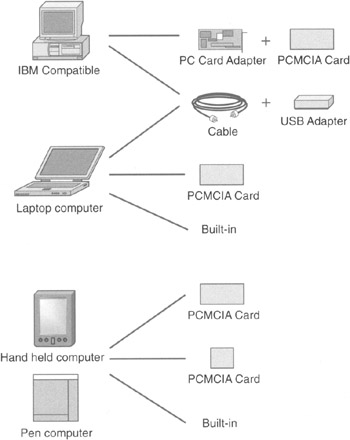
Figure 7-14: 802.11 client adapter choices
For a desktop computer, basically two choices are available: an internal or an external installation. The easiest installation is an external Wi-Fi adapter. The installation is really simple; the unit plugs into the Universal Serial Bus (USB) port. The disadvantage of this type of product is that in public spaces the PCMCIA card tends to wander off if not properly secured. Some external Wi-Fi adapters have a little oval hole that can receive the same kind of cable used to secure laptops.
For the internal installation, two different products are available. One is an adapter that takes a standard PCMCIA card and adapts it to a PC card adapter that fits in a PC slot. This type of adapter enables the user to remove the PCMCIA card and use it in another computer. Like the external USB Wi-Fi adapters, the PCMCIA card may get stolen if not properly secured. Another product that is a PC card has all of the radio equipment built in. Typically, the antenna attaches externally to the PC card with a microwave connector. The major disadvantage of the internal installation is that it takes some PC installation skills, and many of the adapters will not work on PCs that run Apple operating systems.
Laptops offer three choices. The most common approach is to use a PCMCIA card. However, more and more laptops have a Wi-Fi adapter built in. One can also use an external USB Wi-Fi adapter, a PCMCIA card, or a built-in Wi-Fi. An external USB adapter is difficult to carry in a laptop bag due to its size. However, it can be used with a variety of computers. Handhelds and tablets can use a PCMCIA card or a Compact Flash (CF) card, or have a Wi-Fi adapter already built in.
More and more computers are shipping with built-in Wi-Fi. Considering that a built-in Wi-Fi adapter does not stick out of the laptop where it might break off or have to be inserted every time it needs to be used, it's much more convenient to have it built in. However, one needs to take a careful look as to the upgradeability of a built-in adapter. In the near future, 802.11 will be correcting the flaws with its security protocol, Wired Equivalent Privacy (WEP). This upgrade will require more processing power. Also, a whole alphabet soup of new protocols are currently being developed. Therefore, a laptop with a built-in Wi-Fi adapter without upgrade capabilities may quickly become obsolete.
Another thing to consider is that many of the tools for Wi-Fi are chipset dependent. Examples of these are roaming clients, network sniffers, and protocol analyzers. These typically will only run certain brands of cards. For example, Boingo's roaming client will work only with a certain subset of network interface cards (NIC). Check the compatibility of prospective NICs using the chart at www.boingo.com.
How to Look at the Specs Perhaps the most important spec to consider when looking for 802.11 equipment is receive sensitivity. This is the signal strength required for the card to overcome channel noise. A good receive sensitivity (a lower dB number) means little signal sensitivity is needed to acquire the signal. For example, a receive sensitivity of -86 dBm may be okay, but a receive sensitivity of -91 dBm is better. Usually, this figure is part of the specifications. If it is not listed, then usually it's not worth bragging about. Freenetworks.org offers a reasonably current and inclusive chart of the receive sensitivity for various cards.
The next figure to look for is transmitter output. This is expressed in mW or in dBm. Typically, a transmitter will have an output between 20 and 100 mW (or 13 and 20 dBm). It is desirable to be able to control the output power so that interference issues can be mitigated. The combination of receiver sensitivity and transmitter is a major contributor to range.
It is useful to have removable antenna connectors on both APs and client adapter cards. Usually, the connectors are nonstandard, employing either a reverse polarity or a reverse thread from common connector styles. An external antenna connector enables the user to work with antennas to shape where the signal goes. Client cards with external antenna connectors such as the Orinoco Gold card can be connected to desktop antennas such as the Orinoco indoor range extender antenna. This type of antenna can double the range over an ordinary client adapter card.
How to Buy the Right AP Depending on your application, several choices of Wi-Fi APs are available. First, ask yourself if your application can work with a consumer product or if it needs a commercial product.
Consumer Applications Residential APs feature low prices, a minimum feature set, and minimal support. However, several configurations can be bought: an AP; an AP and router combination; and an AP, router, and print server combination. If you already have a Digital Subscriber Line (DSL) or a cable modem and a router/switch, buy an AP. If you have only the DSL or cable modem, then buy a combination router/switch/AP.
Some AP special features enhance QoS or speed. Some examples of consumer manufacturers are Linksys, Intel, Microsoft, D-Link, Netgear, Belkin, HP/Compaq, and Siemens. If you need more than these features, you will need to look at a commercial AP.
Commercial Applications A commercial AP offers many more sophisitcated features than a standard AP. Such features include a plenum rating (which enables you to put an AP into the ceiling of a commercial building), Power over Ethernet (PoE) (which enables you to power the AP through Ethernet cable), or 802.1x/Extensible Authentication Protocol (EAP) (which enables you to authenticate users against a Radius server). Although more expensive, commercial APs have a full feature set, with higher reliability and quality, and more security features. Some examples of commercial manufacturers are Cisco, Lucent/Orinoco/Agere, Proxim, 3Com, and Enterasys.
The WAN Connection
The wide area network (WAN) is the limiting part of the wireless network. The Internet backbone has plenty of bandwidth and the Wi-Fi APs have plenty of bandwidth, but the WAN connection to the Internet is bandwidth limited. The choices currently available are
-
Fractional DS3
-
T1
-
Frame relay
-
Cable
-
DSL
-
Integrated Services Digital Network (ISDN)
-
Wireless
Basically, you get what you pay for.
The Local Exchange Carriers (LECs) provide the ISDN and DSL. Bandwidths 128 to 768 Kbps are common. Wireless and cable providers can offer up to 1.5 Mbps connections, but often they are not reliable depending on the service level agreements (SLAs) you get. Sometimes repair time is a major issue. If the service fails, the provider may wait until the next business day to repair the problem. These are a low-cost choice and intended for the consumer market. The Terms of Service (ToS) usually don't allow you to resell the service. If you get a business subscription, the TOS and SLA may be more agreeable towards a faster repair time, allowing you to resell the connection.
Fractional DS3, T1, and frame relay are all point-to-point services also provided by the LECs and don't come with Internet service. To get Internet service, you need to run the backhaul to an ISP or to a network AP and become your own ISP. QoS would be maintained throughout the network. Of course, T1 and frame relay are priced as a business and thus are available at a much higher cost. The bandwidth of a T1 or frame relay is 1.5 Mbps. Fractional DS3 is an aggregate of several T1s. Bandwidth is in multiples of 1.5 Mbps up to 45 Mbps and is priced accordingly.
How to Extend Range
The range of Wi-Fi systems can be increased with antennas and amplifiers.
Amplifiers It is best practice to use the minimum power required. However, sometimes the range with off-the-shelf equipment is simply not enough to do the job. It is possible to extend the range of an AP by increasing the transmitter power, but this is limited by the legal limit, the receive link, and, ultimately, interference. FCC regulations limit the transmit power output (refer to "FCC Regulations"). If you use an amplifier to increase the transmit power, the transmit range will be increased, but it will also be necessary to either increase the power of the other transmitter or increase the receive sensitivity of the receiver since the link budgets have to be more or less balanced. Increasing power also has another drawback: It causes interference to other users and does not eliminate sources of interference on the receive side. Both amplifiers used on the transmitter and receiver also have another drawback. Amplifiers blindly increase both the signal and the noise. Usually, amplifiers are used in combination with good antenna systems.
Amplifiers are available for use on the 2.4 to 2.4835 ISM band with a power output up to 1 watt. Models with more power output can be used, but they are only usually sold to licensed amateur radio operators or to export and military accounts. Amplifiers are built for a variety of applications on the ISM band. Thus, it is important to buy one that is suitable or optimized for the modulation (FHSS, DSSS, and/or OFDM) that is being used. Most amplifiers are usually intended to mount right at the antenna and are often fed DC power over coax with an injector. The amplifier has to have a signal applied to it that is within a certain power level. Feeding the amplifier with too much signal will cause it to have more power in the sidebands or "splatter." With not enough power, the amplifier will transmit too much noise on the signal.
Certain specifications should be considered when buying amplifiers. These include harmonic products (which should be less than 70 dB), the noise figure of the receiver (the lower the better), a fast-acting auto-sense TX/RX switch (which should be fast enough for 802.11), and an AGC receiver (which prevents overloading the receiver in the presence of strong signals).
Antennas Antennas offer another way to increase the range. Antennas limit energy directed in certain areas and redirect the energy in other areas. All antennas exhibit this to a certain extent. A theoretical antenna point source called isotropic is used as a reference for all other antennas. Thus, the gain of an antenna is measured in terms of dBi, which stands for decibels relative to an isotropic radiator or decibels over isotropic. Omni-directional antennas generally have between 2 and 10 dBi, whereas directional antennas can have between 3 and 25 dBi of gain.
FCC regulations limit how much gain a transmitting antenna can have (refer to the section "FCC Regulations"), but antennas have two distinct advantages over amplifiers. One, an antenna offers gains in both the transmit side and the receive side. Thus, the impact on the link budget is balanced. The other is that antennas help the interference problem. The transmitter only transmits the signal where it is needed and the receiver only listens to where the antenna is pointed. This has the effect of limiting interference by not transmitting where other users are while receiving more of the intended signal and less of the interfering station (unless of course the interfering station is located in the same antenna path as the intended station).
A number of antennas are available for both APs and client adapter cards with antenna connectors. On the AP side are omnidirectional antennas like dipoles and collinears, as well as directional antennas like patch, yagi, grid, and dish antennas. Also, special phased arrays are available that are combined with APs. On the client adapter side are desk antennas, handheld yagis, and magnet mounts.
Antennas: AP Side It can be said that the wireless internet revolution is a silent and invisible revolution except for one thing: antennas. Antennas are the one visible aspect of 802.11. The type of antenna employed determines the range and application involved with a given deployment. The following paragraphs describe the advantages and disadvantages of the different antenna technologies employed in 802.11.
Omnidirectional Omnidirectional antennas transmit their signal in all horizontal directions almost equally. The radiation pattern has the shape of a large donut around the vertical axis, as in Figure 7-15.
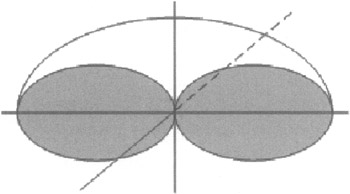
Figure 7-15: Coverage from an omni-directional antenna
The gain is in the horizontal direction at the expense of coverage above and below the antenna. The rubber duckies (the flexible antenna structures on popular access point units) that come with many APs are dipoles that usually have 2.2 dBi of gain. Plenum-rated APs with external dipoles work well mounted above ceiling tiles. Some APs have integrated dipole antennas and are suitable for both walls and ceilings.
For more gain, or an outdoor omnidirectional, consider a collinear antenna. Typically, a collinear omnidirectional antenna looks like a permanent virtual circuit (PVC) pipe that is between one and five feet tall and has an N connector at the end. Gain for these antennas is between 3 and 12 dBi. A collinear antenna is shown in Figure 7-16.

Figure 7-16: Collinear antenna
Vertical This is a garden variety omnidirectional antenna. Most vendors sell several different types of vertical antennas, differing primarily in their gain; you might see a vertical antenna with a published gain as high as 10 dBi or as low as 3 dBi. How does an omnidirectional antenna generate gain? Remember that a vertical antenna is omnidirectional only in the horizontal plane. In three dimensions, its radiation pattern looks something like a donut. A higher gain means that the donut is squashed. It also means that the antenna is larger and more expensive, though no antennas for 802.11 service are particularly large.
Vertical antennas are good at radiating out horizontally; they're not good at radiating up or down. In a situation like this, it is better to mount the antenna outside a first- or second-story window. Verticals, like the rubber 2.2 dBi rubber duckies, are in a sense vertical dipoles.
Dipole A dipole antenna has a figure-eight radiation pattern, which means it's ideal for covering a hallway or some other long, thin area. Physically, it won't look much different than a vertical. Some vertical antennas are simply vertically mounted dipoles.
Directional To shape an antenna to a particular part of a building, patch antennas can be used (see Figure 7-17). For example, one may place a patch antenna near the outside of a building to aim the signal toward the inside of the building. In another case, a patch antenna can be used to limit the signal in an adjoining area. Patch antennas are flat and typically between four and six inches square and have a variety of coax connectors available. They are typically wall mounted. The coverage pattern for a directional antenna looks like Figure 7-18. The gain for a patch antenna is typically between 3 and 15 dBi, and it has a wide beam width.

Figure 7-17: Patch antenna
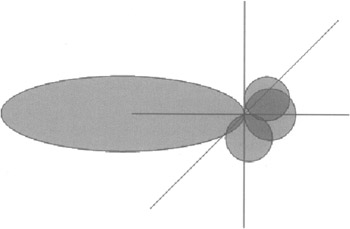
Figure 7-18: Coverage from a directional antenna
Sector panel antennas are often used outdoors to cover a sector of a cell. They typically cover 180, 120, or 90 degrees in beam width and have gains between 12 and 20 dBi. These antennas are commonly fitted with an N connector (see Figure 7-19).

Figure 7-19: Panel antenna
Yagi For a point-to-point shot, consider a Yagi antenna. A Yagi antenna is a moderately high-gain unidirectional antenna. It looks somewhat like a classic TV antenna or like washers threaded on a rod. Often, Yagi antennas are mounted inside a PVC pipe to protect them from the weather. A number of parallel metal elements are set at right angles to a boom. Commercially made Yagis are enclosed in a radome. Yagi antennas for 802.11 service have gains between 12 and 18 dBi; aiming them is not as difficult as aiming a parabolic antenna, though it can be tricky. A Yagi in a radome is shown in Figure 7-20. The gain is fairly high, around 15 to 20 dBi.

Figure 7-20: Yagi antenna in a radome
Parabolic For long-distance point-to-point shots, choose a parabolic grid or a dish antenna. This is a very high-gain antenna. Figure 7-21 shows a parabolic grid antenna. Because parabolic antennas have very high gains (up to 24 dBi for commercially made 802.11 antennas), they also have very narrow beam widths. Parabolic antennas are used for a link between buildings. Because of the narrow beam width, they are not useful for providing services to end users. Vendors publish ranges of up to 20 miles for their parabolic antennas. Presumably, both ends of the link use a similar antenna. Front-to-back ratios and wind load are important factors to consider in parabolic grid antennas.
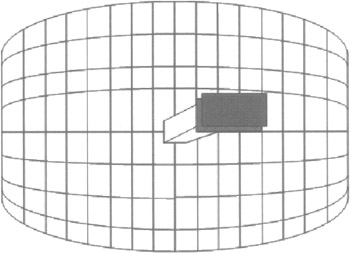
Figure 7-21: Parabolic grid antenna
Electronically Steerable Antennas The best approach to optimize network performance is to maximize the antenna gain to and from the intended subscriber and minimize it elsewhere. Recently, hockey-puck-shaped steerable antennas, six inches across and three inches high, have become available on 2.4 GHz and offer 6 dBi of gain.[9] These can be used with a laptop. Models that can be adapted to APs will follow.
Another company, Vivato, offers an electronically controlled phased array that claims to have a range of up to 7 km to an ordinary client access card.[10] Vivato's Wi-Fi Switches create highly directed, narrow beams of Wi-Fi transmissions. The Wi-Fi beams are created on a packet-by-packet basis. These narrow beams allow simultaneous Wi-Fi transmissions to multiple devices in different directions. Since power is directed only where it is needed, the switch reduces cochannel interference.
Antennas: Client Adapter Card Side External antennas can be used with laptops to increase their range from APs. These antennas come in two styles: ones that stand on a desk and ones that clip onto the lid of the laptop. They have about a 5 dBi gain and must be bought with connectors that match the external antenna connector of the client access card.
A handheld Yagi antenna can be used to find rogue APs or in a site survey to find sources of RF. They are highly directional, with narrow beam widths and about 10 dBi of gain to make it easy to follow the lead to the RF source. Typically, these have an N-type female connector on them. Adapting them to your client access card requires a short piece of coax that has an N-type male connector and a microwave connector that matches the client access card on the other. This special piece of coax is sometimes referred to as a pigtail.
Another type of antenna is a magnet mount. Unlike the handheld Yagi, it's omnidirectional and has only 5 dBi of gain. It can be used to survey areas for RF sources while driving around (called war driving) or it can enable you to utilize hotspots in the convenience of your car.
Antenna Specifications Table 7-7 shows typical specifications for antennas and how to interpret them.
| Frequency range | Should cover at least 2.4–2.4835 MHz. |
| Gain | Should be expressed in dBi. This figure depends on the antenna. |
| VSWR | 1.5:1 or 2:1 maximum is typical; lower is better. |
| Polarization | Vertical, horizontal, or circular |
| Half-power beam width | Degrees for vertical and horizontal. This depends on the purpose of the antenna. |
| Front-to-back ratio | This depends on the purpose of the antenna. |
| Power handling | Should handle the transmitter's output power at three times the amount. |
| Impedance | Should match the transmitter. Usually 50 Ohms. |
| Connector | N-female is common because it is the strongest, but others are available on commonly available antennas. |
Gain The gain of the antenna is the extent to which it enhances the signal in its preferred direction, and it is measured in dBi. An isotropic radiator theoretically radiates equally in all directions. Simple external antennas typically have gains of 3 to 7 dBi. Directional antennas can have gains as high as 24 dBi.
Half-power Beam Width This is the width of the antenna's radiation pattern, measured in terms of the points where the antenna's radiation drops to half its peak value. Understanding the half-power beam width is important to understanding your antenna's effective coverage area. For a very high-gain antenna, the half-power beam width may be only a couple of degrees. Once outside the half-power beam width, the signal typically drops off quickly, depending on the antenna's design. An antenna's receiving properties are identical to its transmitting properties. An antenna enhances a received signal to the same extent that it enhances the transmitted signal.
Non-standard Connectors Unlicensed transmitters operating under Section 15.203 are required to be designed so that no antenna other than the one furnished by the party responsible for certifying compliance is used with the device. This can be accomplished by using a permanently attached antenna or a unique coupling at the antenna and at any cable connector between the transmitter and the antenna. FCC Part 15.203 states that intentional radiators operating under this rule shall be designed so that no antenna other than that furnished with the radiator by the responsible party shall be used with the device. The reason for adopting this rule is to prevent the use of unapproved, after-market, high-gain antennas or third-party amplifiers with a device or system.
To meet this requirement, the FCC allows several options. The first option is a permanently attached antenna. These antennas usually include those devices that the box must be opened for in order to remove the antenna. A nonstandard, tamperproof screw secures the antenna to the box, the antenna is soldered to the box, or the antenna is molded into the radio.
The second option is that the antenna be professionally installed. However, the FCC's definition had been somewhat ambiguous. For the most part, high-gain antennas designed to be mounted on a building exterior or a mast generally fall under the professional-installation clause. It's generally understood that a "professional" is one who is properly trained and whose normal job function includes installing antennas. Several groups, including Cisco, the Certified Wireless Network Professional (CWNE) Program, and the National Association of Radio and Telecommunications Engineers (NARTE), are offering certification programs for unlicensed wireless system installers that would qualify an installer as a professional.
The third option allows a nonstandard or unique connector to secure the antenna to the transmitter. Standard clearly includes connectors such as TNC, BNC, F, N, SMA, and other readily available connectors. The usual convention is that the male connector has a pin in it, and it also has the threads on the inside. More esoteric connectors, such as MCX and MMCX or connectors that are similar to the standard connectors with reversed threads, nonstandard threads, nonstandard shells, or with the gender reversed, are incorporated into Wi-Fi equipment. Some common examples are RP-TNC, RP-BNC, and RP-SMA. Basically, an RP-TNC chassis connector has a male core and a female outside. That is, the threads are on the outside of the connector, but the connector has a pin in it. The mating part has a female core and the threads on the inside. If you need these nonstandard connectors, rest assured they are difficult to find. The best place to get them is over the Internet.
Lightning Protection, Grounding, and Bonding It is important to properly ground any external antenna. Many volumes have been written about lightning protection, grounding, and bonding. Refer to these and the manufacturer's suggestion. However, if these are not provided, one of the key things to do is to provide an adequate ground through a ground rod. A ground lead should run from the rooftop antenna clear down to the ground rod with a minimum of bends in the line. The Ethernet connection should have a lightning arrestor on it that is connected to the ground system before going into the building. Also, it is helpful to put a loop in the Ethernet cable near the AP or bridge and near where it goes into the building.
RF Propagation Relative to deploying Ethernet cable to install a wired network, RF propagation can be a difficult science. The following pages describe the engineering challenges related to installing a wireless network, particularly regarding limitations in range.
Multipath Interference One of the major problems that plague radio networks is multipath fading. Waves are added by superposition. When multiple waves converge on a point, the total wave is simply the sum of any component waves.
When two waves are almost exactly the opposite of each other, the net result is almost nothing. Unfortunately, this result is more common than you might expect in wireless networks. Most 802.11 equipment uses omnidirectional antennas, so RF energy is radiated in every direction. Waves spread outward from the transmitting antenna in all directions and are reflected by surfaces in the area. Figure 7-22 shows a highly simplified example of two stations in a rectangular area with no obstructions.
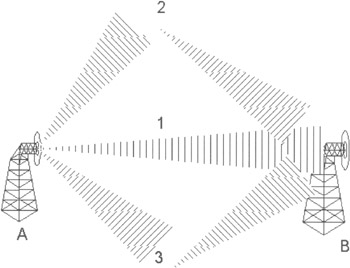
Figure 7-22: Multiple wave paths in an unobstructed field
This figure shows three paths from the transmitter to the receiver. The wave at the receiver is the sum of all the different components. It is certainly possible that the paths shown in Figure 7-22 will all combine to provide a net wave of 0, in which case the receiver will not understand the transmission because no transmission exists to be received.
Because the interference is a delayed copy of the same transmission on a different path, the phenomenon is called multipath fading or multipath interference. In many cases, multipath interference can be resolved by changing the orientation or position of the receiver.
Intersymbol Interference (ISI) Multipath fading is a special case of intersymbol interference. Waves that take different paths from the transmitter to the receiver will travel different distances and be delayed with respect to each other, as in Figure 7-23. Once again, the two waves combine by superposition, but the effect is that the total waveform is garbled. In real-world situations, wavefronts from multiple paths may be added. The time between the arrival of the first wavefront and the last multipath echo is called the delay spread. Longer delay spreads require more conservative coding mechanisms. 802.11b networks can handle delay spreads of up to 500 ns, but performance is much better when the delay spread is lower. When the delay spread is large, many cards will reduce the transmission rate; several vendors claim that a 65 ns delay spread is required for full-speed 11 Mbps performance at a reasonable frame error rate. A few WLAN analysis tools can directly measure delay spread.[11]

Figure 7-23: Intersymbol interference
Using Two Antennas for Diversity Diversity is often used with cellular base stations to help overcome multipath problems. Many APs have two antenna connectors for diversity, but exactly how is diversity can be implemented besides connecting two rubber duckies has been left to the radio system designer.
Anyone who listens to a car radio while driving in a downtown urban environment has experienced a momentary dropout or fading of the signal at any given stoplight. If you at this point move forwards or backwards ever so slightly, the station comes back in. Although the car is in range of the radio tower, no signal is received in these dead spots. This phenomenon is called multipath fading and is the result of multiple signals from different paths canceling at the receiver antenna. Figure 7-24 shows multipath cancellation from a large building.
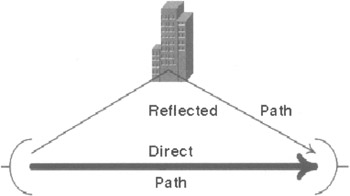
Figure 7-24: Multipath
Five different types of diversity can be used to increase signal reception in the presence of multipath fading: temporal, frequency, spatial, polarization, and angular. The first two types of diversity require changes in hardware.
Temporal diversity involves lining up and comparing multiple signals and choosing the one that best matches the expected time of arrival for a signal. This concept is implemented in some digital technologies. One of the most common temporal diversity methods is to use adaptive equalization and RAKE[12] receivers. These have limited use with Wi-Fi of the large DSP MIPS requirements required to handle large delay spreads.
A RAKE receiver is the digital section of a spread spectrum receiver, which can separate out the relevant signal from all the other signals using multiple correlators thereby providing diversity. See Figure 7-25. However, the use of RAKE receivers in Wi-Fi is limited if no impractical due to the large DSP MIPS requirements required to handle large delay spreads.
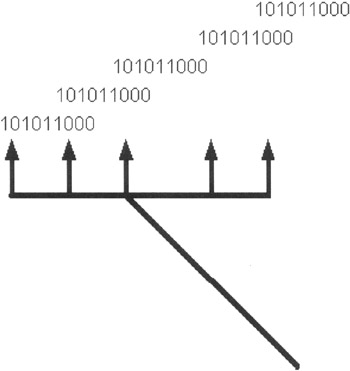
Figure 7-25: A Rake receiver
Frequency diversity can be implemented by using two separate radio links on two different channels. If a null exists due to the cancellation of two signals because of a reflection, it will not happen on another frequency at the same place. Routers at both ends of the link can be used to send data across both wireless links. If one fails due to fading, the effective throughput is decreased. The redundancy of the link would also provide protection for other cases of failure.
Spatial diversity helps overcome the multipath problem by using two identical receive antennas separated by a fixed number of wavelengths. If a null happens due to a cancellation of the two signals, it will not happen at the other antenna. Since the antenna with the strongest signal is selected, the link is more likely to survive a fade when using spatial diversity.
The multipath problem can be helped with antennas mounted at different angles to cover the same coverage area. If a signal from one antenna and its reflection are cancelled, then a signal from a different antenna arriving at a slightly different angle will probably not cancel because the phase has changed. Again, since the antenna with the strongest signal is selected, the link is more likely to survive a fade when using angular diversity.
Finally, the multipath problem can also be mitigated by transmitting and receiving using two feed horns that utilize both vertical and horizontal polarization (or clockwise and counterclockwise polarization). When electromagnetic waves are reflected off of flat surfaces, their polarization can change. When the reflected wave and the direct wave combine to form a null, if the wave had been sent using the opposite polarization, no such cancellation would occur. Since the antenna with the strongest signal is selected, the link is most likely to survive a fade when using polarized diversity.
Weatherproofing It is important to seal all outdoor connections, but it has to be done in such a way that the sealing can be removed if necessary. Use a combination of vinyl-backed mastic tape, heat-shrink tape, and high-quality electrical tape to seal the connector from moisture. Don't use silicon-based products or other spray-on or brush-on weatherproofing materials. They are very difficult to remove.
Locating Your AP to Where No Power Exists
In places where an AP cannot be powered, such as inside a plenum, an attic, or on top of a roof, it costs about $800 to get an electrician to run power per code, in addition to the $200 to run Cat 5 cable from the wiring closet to the AP. A number of commercial AP manufacturers (Symbol, Lucent, and Cisco) have added PoE into their product designs to bring power over the spare pairs of the Ethernet cable to the AP (see Figure 7-26). An injector is located in the wiring closet close to the power outlet. Their APs take power from spare pairs as part of their design. Also, a number of manufacturers are now offering PoE add-ons for most APs in the form of injectors and taps.
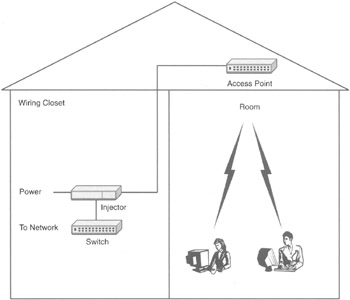
Figure 7-26: PoE in an office
PoE also enables you to place the AP much closer to the antenna, thus reducing signal loss over antenna cabling. An Ethernet signal is carried well over Cat 5 cable, but RF signals at 2.4 and 5.8 GHz are heavily attenuated over coax. Also, Ethernet cabling is much cheaper than coax (see Figure 7-27).
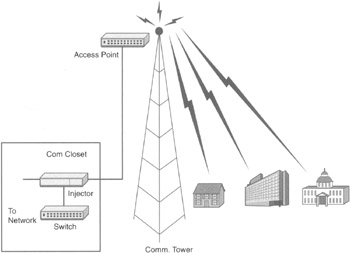
Figure 7-27: PoE in WLAN
The wiring for PoE is relatively simple (see Figure 7-28). Power is carried over 4&5 and 7&8. However, the polarity differs from one manufacturer to another. Most manufacturers use 4&5 to carry the positive lead and 7&8 to carry the negative lead of the power supply. Cisco's polarity is opposite to what is shown in the schematic.

Figure 7-28: Simplified schematic of PoE injector and tap
Besides the polarity, the voltages differ between manufacturer and by model (see Table 7-8). The best practice is to stick with one standard and thus only the vendors of equipment that run on the same voltage and polarity. The IEEE is working on a new standard for PoE called IEEE 802.3af. The new standard will allow equipment from different manufacturers to sense the voltage and polarity of the power that is being supplied on the spare wires of the Ethernet cable and adapt to it.
| Pins 4&5 + and Pins 7&8 - | Pins 4&5 - and Pins 7&8 + | |
|---|---|---|
| 5V | ||
| 12V | Intel, 3 Com, Symbol, Orinoco | |
| 24V | Intel, 3 Com, Symbol, Orinoco | |
| 48V | Cisco |
How to Overcome Line-of-Sight Limitations
The biggest challenge to providing Internet access over a WLAN is line of sight. One of the keys to success as a WISP is to get sites with lots of height above the average terrain or in hilltop locations and link those together using long-haul connections. From the key locations, it's possible to bring the signal to neighboring sites within a thousand feet or so. Also, it's then possible to extend service from one location to a few more as long as redundant paths are brought in to cover the new location. Perfect line of sight is not necessary when the signal is strong enough. It's usually best to set up the wireless backhaul on 802.11a where the noise picture looks better and where the wireless customer won't interfere with the backhaul when installing either 802.11b or 802.11a for the premise (see Figure 7-29).
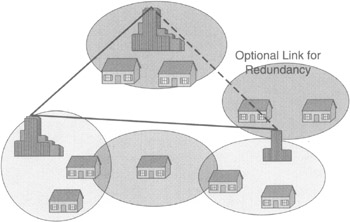
Figure 7-29: Tiered network to overcome line-of-sight limitation
How to Overcome Interference Limitations
The second biggest challenge to WISP is interference. One of the keys here is to use a band for backhaul that is less congested than the 2.4 GHz band. The 5.8 GHz band fares well for this, except that the range is not nearly as good as the theoretical range on the 2.4 GHz band. Although the 900 MHz band has been touted as being crowded, it may not be as crowded as the 2.4 GHz band. The 900 MHz band has one more advantage: It has much better penetration through vegetation.
[2]Edward C. Jordan, ed. Reference Data for Engineers: Radio, Electronics, Computer, and Communications (Howard W. Sams and Co., Indianapolis, IN 1986).
[3]Anil Shukla, "A Generic Vegetation attenuation model for 1-60GHz: PM3035," www.radio.gov.uk/topics/research/topics/propagation/vegetation/veg-attenuation-model.pdf.
[4]"Glass That Cuts Signals," www.isp-planet.com/fixed_wireless/technology/2001/tint_bol.html.
[5]John C. Stein, "Indoor Radio WLAN Performance Part II: Range Performance in a Dense Office Environment," Intersil Corporation, 1997, www.intersil.com/design/prism/papers/symposum.pdf.
[6]AWE Communications, www.awe-communications.com.
[7]Wireless Valley, www.wvcomm.com.
[8]University of Cantebria, Spain, www.gsr.unican.es.
[9]See www.paratek.com.
[10]See www.vivato.net.
[11]See www.vivato.net, pp. 158–163.
[12]The word "RAKE" is not an acronym but is commonly written in all capitals in the literature. RAKE derives its name from its inventors Price and Green in 1958. The multiple correlators from the rake's fingers and the retrieved signal forms the handle of the rake. R. Price and P. Green, "A communication technique for multipath channels," Proceedings of the IRE, pp. 555-570, 1958.
|
|
EAN: 2147483647
Pages: 96